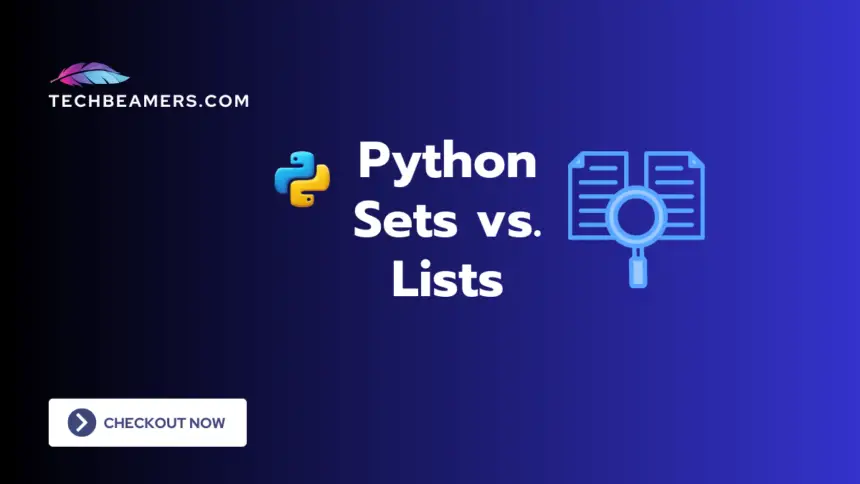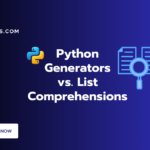Welcome to this tutorial on Python Sets vs Lists. As a programmer, understanding the differences between sets and lists is essential for writing efficient and clean code. In this tutorial, we’ll dive into the characteristics of sets and lists, explore their use cases, and help you make informed decisions when choosing between them.
The Difference Between Python Sets vs Lists
Let’s dive into the thin and thin of Python Lists and sets. Try to grasp more on how these two differ from each other.
Lists: Ordered and Versatile
Let’s start with lists. Lists are a fundamental data type in Python, providing a way to store and organize elements in a specific order. They are defined by square brackets [] and can contain various data types, including numbers, strings, or even other lists.
Creating Lists
fruits = ['apple', 'banana', 'orange', 'grape']
numbers = [1, 2, 3, 4, 5]
mixed_list = ['apple', 42, 3.14, True]You can access elements in a list using indexing. For example:
print(fruits[0]) # Output: 'apple'
print(numbers[2]) # Output: 3List Operations
Lists support various operations like appending, extending, and list slicing:
fruits.append('melon') # Add 'melon' to the end
numbers.extend([6, 7, 8]) # Extend the list with more numbers
sliced_list = mixed_list[1:3] # Extract elements from index 1 to 2Sets: Unordered and Unique
Now, let’s shift our focus to sets. Sets are another built-in data type in Python, defined by curly braces {} or the set() constructor. They differ from lists. They are unordered and consist of unique elements.
Creating Sets
unique_numbers = {1, 2, 3, 4, 5}
unique_fruits = set(['apple', 'banana', 'orange', 'grape'])Sets automatically eliminate duplicate values. If you try to add a duplicate element, the set won’t permit it:
unique_numbers.add(3) # Won't add 3, as it's already in the setSet Operations
Sets come with powerful operations like union, intersection, and difference:
set1 = {1, 2, 3, 4, 5}
set2 = {3, 4, 5, 6, 7}
union_set = set1 | set2 # Union: {1, 2, 3, 4, 5, 6, 7}
intersection_set = set1 & set2 # Intersection: {3, 4, 5}
difference_set = set1 - set2 # Difference: {1, 2}Differences Between Sets and Lists
Now, let’s check up on how a list is different than a set in Python
Uniqueness and Order
The primary distinction lies in the uniqueness and order of elements. Lists maintain the order in which elements are inserted and allow duplicates. On the other hand, sets are unordered and automatically enforce uniqueness.
Use Cases
- Use Lists when:
- You need to maintain the order of elements.
- Duplicates are allowed.
- Sequential access to elements is important.
- Use Sets when:
- Uniqueness is crucial, and duplicates should be avoided.
- The order of elements is not significant.
- You need to perform set operations like union, intersection, or difference.
When to Use Lists
These are some common scenarios where you should be using a list.
Scenario 1: Maintaining Order
Consider a scenario where the order of items matters, such as keeping track of tasks in a to-do list:
to_do_list = ['Wake up', 'Have breakfast', 'Work on project', 'Go for a run']Here, the order of tasks is crucial, making a list the suitable choices.
Scenario 2: Duplicate Elements
If your data allows duplicate elements and you need to preserve their order, a list is the way to go. For instance, a list of temperatures recorded throughout the day:
temperature_readings = [23, 25, 23, 22, 25, 24, 22]When to Use Sets
Now, let’s highlight some use cases where you should be using a set.
Scenario 1: Unique Elements
Suppose you are dealing with a dataset of unique user IDs, and you want to ensure there are no duplicates:
unique_user_ids = {1234, 5678, 9012, 3456}Using a set guarantees uniqueness, and it also allows for efficient membership tests.
Scenario 2: Set Operations
When you need to perform operations like finding common elements between two datasets, sets are incredibly handy:
set1 = {1, 2, 3, 4, 5}
set2 = {3, 4, 5, 6, 7}
common_elements = set1 & set2 # Output: {3, 4, 5}Conclusion – Python Sets vs Lists
In conclusion, both sets and lists have their unique strengths and use cases. Lists maintain order. They allow duplicates and are suitable for scenarios valuing element sequences. Sets prioritize uniqueness. They excel in efficient membership tests and set operations.
As you navigate the world of Python programming, understanding when to use sets or lists will empower you to write more efficient and readable code. Choose the right tool for your tasks.
Happy Coding,
Team TechBeamers









